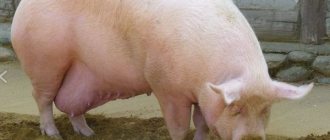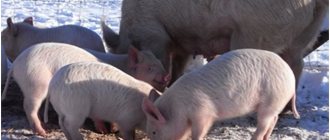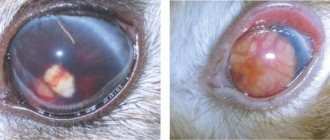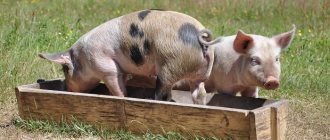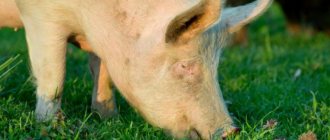Erysipelas in pigs This disease is dangerous not only for animals, but also for people. Despite the fact that deaths are rather exceptions to the rule, this does not reduce the danger at all. Erysipelas pathogenic microorganisms lead to many complications subsequently developing in humans and animals. These are problems with cardiovascular activity, joints, and changes in the morphological nature of internal organs. However, if diagnosis is carried out on time, as well as successful treatment, the negative impact is significantly reduced.
The causative agent of the disease
Today, keeping and breeding animals is very popular - in domestic and industrial farms you can find not only birds, cattle, but also pigs, which are allowed to be kept only with a positive decision from the veterinary station of your region.
Pig breeding is a popular farming activity in Russia
Pigs grow quite quickly, develop well and produce offspring of up to 40 piglets per year from one sow. A big plus is their resistance to diseases, however, there are exceptions in this regard. Recently, diseases that can reduce your livestock by several times are becoming more and more common - erysipelas is one of them.
Erysipelas
The virus and its “habitat”
The bacterium “Erysipelothrix insidiosa” is the causative agent of erysipelas in pigs, causing disease when it enters the body of animals and humans. The virus itself is extremely tenacious, it easily adapts to external climate changes and is found everywhere, which complicates preventive work.
The autopsy protocol of dead pigs shows that the rod easily changes its structure and germinates in any favorable environment, but cannot move independently or form spores. Anamnestic studies of virologists suggested how to prevent the occurrence of the disease and what preventive actions should be taken to achieve this on pig farms.
The easiest way to fight the disease is with high temperatures (more than 70 degrees Celsius) and disinfectants. You can read more about ways to prevent the spread of the virus in the article “Treating erysipelas in a pig at home.”
Sources of erysipelas diseases
The causative agents of erysipelas are found in soil and water, and therefore it is not possible to completely get rid of them. Most often, piglets between three months and one year of age become ill. The carriers of erysipelas can be:
- rodents;
- birds;
- cattle;
- mosquitoes, ticks and other blood-sucking creatures.
External signs of the disease
Despite the fact that all of these carriers can infect pigs, they themselves do not necessarily have to be sick with erysipelas. The fact is that for some animals this bacterium is not a pathogen, and they simply transfer it from sick to healthy ones. Healthy animals can also shed this infection through their droppings or urine.
It's no secret that pigs are considered omnivores. That is why owners often feed them various waste, including meat and sausages. In turn, meat from recovered pigs can be used in sausages and, if it has not been sufficiently processed, can cause the development of disease after ingestion.
Poor nutrition negatively affects the immunity of animals in general
Pigs can only get erysipelas directly through a carrier if they eat them, but such situations practically never occur. Most often, infection occurs through objects that animals come into contact with:
- food/water that the hosts ate/drank (rodents, pigeons and other birds);
- devices and tools used by the owner;
- litter, especially old litter;
- floor and walls of the barn;
- land in which the corpses of dead animals up to one year can be buried;
- manure (the infection lives in it for several months);
- insects sucking blood (in the case when, in front of a healthy animal, they sucked the blood of a sick one).
Infection can even occur through a mosquito bite
Despite the many ways and mechanisms of infection with erysipelas, the most common is contact with soil. Therefore, the peak of the disease occurs in spring and autumn, since in the winter the infection is too cold, and in the summer it is too hot.
Features of vaccination
Vaccination of pigs against erysipelas is a prerequisite for preventing the development of an infectious process among livestock.
Vaccination against erysipelas, according to the vaccination plan, is given to piglets at the age of 60-70 days. Repeated administration of the vaccine is carried out at the age of 72-84 days, then at 100-115 days. Adults require booster vaccination every 5 months.
Against this infectious disease, drugs such as the Deposited vaccine against swine erysipelas or the Vaccine against swine erysipelas from the BP-2 strain are used.
The injection technique depends on the age of the animals:
- For small suckling piglets, the injection is injected subcutaneously into the triangle behind the ear; the drug can also be injected subcutaneously into the inner thigh;
- After weaning, piglets can be injected with the vaccine intramuscularly, in the neck behind the ear;
- In older animals, the vaccine is administered into the thigh, intramuscularly.
This video explains what vaccines against swine erysipelas exist and how to properly vaccinate:
Erysipelas in pigs is an infectious disease that poses a danger not only to animals, but also to humans. The causative agent of the disease is resistant to environmental conditions and is able to survive in the bodies of dead pigs. The best way to prevent this disease is timely vaccination.
0
0
Copy link
Forms of the disease and their corresponding symptoms
The most common of the three types during erysipelas is type A, the second type B is much less common. Any type of disease can exist inside a healthy body in a latent, inactive form. When the immune system first weakens, the pathogen can become active. This is precisely the reason why a pig becomes infected with erysipelas, if there has been no introduction of infection into the farm from the external environment.
It is impossible to determine the exact external symptoms, since they depend solely on the form and stage of the disease. The incubation period can last from one to eight days. According to the course of the disease, there are four types:
- lightning;
- acute;
- subacute;
- chronic.
Bacteria that cause erysipelas live in the soil
To these four, three more forms can be added: septic, cutaneous and latent. During the latter, the animal carrying the infection often appears completely healthy outwardly, but it can infect others.
Lightning form
This species is often found in piglets aged 8-11 months. Death occurs in 100% of cases within a couple of hours, so this form is rarely diagnosed and it is almost impossible to start treatment in time.
Symptoms that indicate the presence of a fulminant type of erysipelas infection:
- temperature reaches 41-42 degrees;
- pigs completely refuse to eat;
- animals are in a depressed state, passive;
- Symptoms of central nervous system damage may occur.
Piglets with lightning-fast erysipelas
Sometimes these signs are supplemented by the appearance of red-violet spots on the body. Most often they are located in the neck, hips or intermaxillary area.
Apart from this symptom, which may not appear in this form, no other signs are visible. It may seem as if the pig died for no reason. It is possible to find out that it was precisely erysipelas in this form only by opening the animal and performing certain tests.
Unexpectedly dead animals must be sent to the laboratory for autopsy.
Acute form of the disease
This form is also called septic. Already during the first time of infection, several symptoms appear:
- temperature rises to 42 degrees;
- the animal has a fever, chills;
- the pig is in a weak, suspended state;
- lack of appetite.
Septic form of erysipelas
These symptoms are further joined by several more:
- pigs constantly lie down and do not want to get up;
- the hind legs are not able to withstand the load;
- while walking the pigs stagger;
- conjunctivitis may appear;
- vomit;
- problems in the gastrointestinal tract, constipation.
After a day or two, pink spots appear on the skin, slightly protruding above the surface. Subsequently, these spots acquire a dark burgundy hue - this means that the death of the animal will occur very soon. If you press on these spots, they will begin to fade. Small bubbles may also appear on top of the spots.
Critical manifestations of erysipelas
During the disease, the lungs begin to swell, the cardiovascular system is weakened and, accordingly, the pig very quickly loses strength, its condition deteriorates sharply. The pig's pulse weakens to 95-110 beats per minute. The skin begins to turn blue. Two to four days after the first clinical manifestations, the pig dies. Death occurs in 60-82% of cases.
Subacute form of the disease
At the first stage of the disease, the symptoms are the same as the previous, acute form. After one or two days, swelling may form on the body. The spots are initially colorless and then gradually darken to a dark blue hue. They have a diamond shape, growing and merging with each other over time.
This form also has its positive side. The fact is that the subacute form develops only on the surface of the skin, without passing inside the body. Once signs of urticaria appear, the disease will begin to subside and the pig will recover within 11-13 days.
Hives in a pig
Sometimes this form can be accompanied by complications. You can find out that the disease is dangerous already by the first symptoms, when diffuse inflammation also appears when urticaria appears. It is easier to kill such sick people right away.
Chronic form of the disease
It may be the result of a previous form or may also appear after exacerbations of a latent form. Signs of the disease:
- skin necrosis;
- arthritis;
- endocarditis.
Animals almost always die from this form. The fact is that the pathogen acts on the body from the inside, and even after the animal recovers, after a month and a half, it risks dying.
If the sick individual is not isolated in time, the entire livestock will die
Features of diagnosis and nuances of treatment
Red spots on the body are the main sign of the external manifestation of erysipelas in pigs. Symptoms and treatment of this virus depend on its form and timing of recognition. Above, we said that if the infection progresses at lightning speed, pigs are doomed to death. In other cases, the main thing is to promptly recognize erysipelas and begin treatment.
Unfortunately, it is very difficult to make a 100% diagnosis, because the external signs of erysipelas in pigs are similar to other diseases. Accurate data can only be obtained after an autopsy, since the infection causes pathological changes in the spleen, kidneys, liver and tubular bones.
It is precisely because of the difficulty of diagnosis that treatment is carried out comprehensively. It is not enough to inject only a specialized vaccine, so sick animals are given antiviral and antipyretic antibiotics
During treatment, it is important to feed and water the livestock well. On average, the disease takes 5-7 days, after which the piglets completely return to normal.
Changes in the body after death
In some forms, erysipelas progresses so quickly that it does not have time to appear outwardly. In this case, the disease can be detected only after the death of the animal. In this case, experts highlight:
- pulmonary edema;
- hyperemia;
- sometimes the presence of hemorrhages.
If your animal died suddenly, it is recommended to have it examined by specialists in order to protect the rest of the herd.
The appearance of characteristic spots on a pig’s skin is a reason to sound the alarm.
In the acute form, only formations on the skin in the form of bruises are considered an external symptom. The spleen and lymph nodes enlarge, and sometimes there is the presence of mucus on the organs.
The chronic form of the disease includes dark, almost black growths on the skin, which leave scars. After death, the effect on the bicuspid valve is revealed; damage to the others occurs less frequently. Fibrin appears on the valves, which resembles cauliflower.
Heart damage
Is it possible to eat pig meat with erysipelas?
In addition to animals, erysipelas in pigs is also contagious to humans. Although erysipelas in pigs can cause death on a single occasion, its danger does not become less.
Pathogenic erysipelas can cause severe complications in humans and animals - diseases of the cardiovascular system, articular apparatus and morphological changes in internal organs.
But with timely diagnosis and successful treatment, the negative consequences of this disease can be significantly reduced.
Characteristics of erysipelas bacteria
Porcine erysipelas is caused by a ubiquitous (common) bacterium. Erysipelas is resistant and remains virulent for several months. The bacterium is sensitive to antibacterial agents, bleach, alkalis, formaldehyde and temperatures above 50°C. Low temperatures (-7 -15°C) do not disinfect the pathogen. When heated to 70°C, the bacterium dies within 5 minutes.
Porcine erysipelas is a common disease. Registered as an epizootic (limited). Pigs from 3 months to 1 year become infected.
The source of the disease is sick pigs – bacteria carriers.
Transmission factors include meat from the slaughter of sick animals, contaminated slaughterhouse waste, manure, care items, carcasses of sick animals. The pathogen is carried by mice and flies - bloodsuckers. The route of transmission is nutritional; it is rarely transmitted through vector-borne or direct contact.
Mostly swine erysipelas occurs in the warm season and is stationary in nature.
Clinical picture of erysipelas in pigs
The incubation period lasts from 2 days to a week. The symptoms and treatment of swine erysipelas, the severity of its course and the form of the disease will depend on the factors contributing to the occurrence of the disease.
These factors include:
- virulence of the pathogen;
- gate of infection (place of entry of bacteria);
- state of the animal's immune status;
- conditions of keeping and feeding.
The disease manifests itself in several forms that are characteristic of a certain course.
Classification of the course of the disease:
Each period (course) has its own picture of the disease.
Lightning-fast flow is observed quite rarely. Its manifestation will be typical for fattening pigs of 7 - 10 months, in weakened animals that are kept in unsatisfactory conditions, under the influence of stress factors (transportation). There is no erythematous skin disease; erysipelas during this period is called the white form.
The septic form is noted in acute cases. During this period, sick animals are kept separate from the entire livestock, depressed, and lie down. Body temperature is above 42°C, limbs bend with difficulty when moving (stilted gait). There is loss of appetite, chills, dyspeptic disorders, diarrhea alternating with constipation. Possible attacks of vomiting.
Cardiovascular and renal failure cause pulmonary edema. Decompensatory shortness of breath, cyanosis (cyanosis) of the skin in the area of the lower jaw, neck and abdomen develop.
A characteristic symptom is erythema (redness) of the skin. On the second day of the disease, some pigs develop spots of different colors - from pale pink to dark red.
If left untreated, patients die within 2 to 5 days.
Erysipelas in pigs goes away more easily in the subacute period, in which the skin form is characterized by urticaria. The body temperature of a sick pig reaches 41°C, weakening of the animal and thirst are observed.
With erythematous urticaria, swellings of different configurations form - square, diamond-shaped, sometimes round. Urticaria appears over large areas of the body, and its course is benign.
With treatment and recovery it disappears completely.
The subacute course lasts 6–12 days, the outcome is favorable – recovery.
Rarely becomes septic.
Chronic erysipelas in pigs is rarely recorded. It manifests itself as erysipelas necrosis (death) of the skin, warty endocarditis, rheumatism, and polyarthritis. As a result, lameness develops and joints become deformed.
Treatment
For successful results and effectiveness, treatment of pigs with erysipelas must be comprehensive. Specific and symptomatic therapy is used.
For specific therapy, patients are administered anti-erysipelas serum. Symptomatic therapy includes the use of several groups of drugs:
- broad-spectrum antibacterial;
- vitamins;
- antihistamines;
- cardiac;
- antipyretic.
Antimicrobial drugs (tylosin, tylosomicol, farmazin, penicillin and streptomycin sodium salt) are used for 3 to 5 days. If necessary, continue the course of treatment with long-acting antibiotics (bicillin 3, 5). The optimal therapeutic effect can be achieved by combining antibiotics and anti-erysipelas serum at the same time. The dose of the drug is determined according to the instructions.
Along with the use of medicines, improved feeding and livestock management are being created. Places where sick people are kept are regularly mechanically cleaned and disinfected.
Measures to control and prevent erysipelas in pigs
When swine erysipelas appears, restrictions are introduced in the industrial and private sectors. They relate to the export - import of pig livestock, export of non-disinfected pig products (meat) and feed.
All livestock are subject to clinical examination. Clinical pigs are isolated and treated. Conditionally healthy people are vaccinated and observed for the next ten days. If they become ill, they are also isolated.
If there is a need, sick pigs are slaughtered in designated areas.
Two weeks later, restrictions are lifted after the last detection of the disease and the final forced disinfection of all premises, equipment and walking areas.
Treatment of erysipelas in pigs
Complete treatment must be prescribed by a veterinarian. The bacteria of this disease can be killed by drugs such as tetracycline, penicillin, and erythromycin. It is very important to follow the dose indicated by the veterinarian, calculating it for each kilogram of weight. It is possible to cure animals if you combine a course of antibiotics with anti-erysipelas serum.
Important point! Do not mix serum and antibiotic. This combination will not work and, moreover, you can seriously harm the animal.
Any antibiotic significantly reduces serum function due to its characteristic immunosuppressive effect. Therefore, when using these drugs, it is important to follow the doctor's instructions and both drugs.
“Ruvak” is the most common anti-erysipelas serum
In addition to antibacterial vaccines, treatment is also carried out symptomatically. It involves treating skin wounds when the skin has already begun to come off.
It is very important to provide pigs with constant access to warm water during this period. All sick animals must be sent to a separate barn. They can be transferred back only two weeks after absolutely all symptoms have passed.
Treatment of this disease is carried out according to a long-established scheme. It is necessary to contact a veterinarian for instructions, but taking animals to the clinic is not. You can cure pigs yourself. The main thing to remember is that treatment should be carried out strictly according to the instructions, using antibiotics and other drugs. Some owners prefer folk remedies. This is a fundamentally wrong decision, since you cannot kill the bacterium itself, the causative agent of the disease, and the animal will subsequently die.
Monitor the health of your animals
Treatment options
If the first signs of pathology occur, you must immediately call a veterinarian , who will conduct an examination and tell you what to do in a particular case. The likelihood of recovery depends on the type, stage of the disease, age and health of the animal. The chance of healing increases if therapy is started no later than 15 hours after the first signs of damage appear.
Anti-erysipelas serum
The most effective way to treat erysipelas in pigs is the use of special serums . The type, dosage and duration of use of the anti-erysipelas drug is selected by the veterinarian.
Subcutaneous and intramuscular administration of the solution at a rate of 1.5 ml. per 1 kg. weight. In severe cases, the serum is administered not entirely, but in parts, at 40-minute intervals. If after 12 hours there are no signs of improvement, the serum is administered again.
Erysipelas vaccine
To minimize the risk of infection and prevent loss of production , it is necessary to take preventive measures . vaccine helps prevent the onset of the disease . Similar products are produced by different manufacturers, so they differ in action and cost.
to select a drug and carry out vaccination together with a veterinarian. Typically, the first vaccination is given at the age of 3 months, the second at 4 months, and the third six months later. After administration of the drug, the production of antibodies is activated, preventing the spread of the pathogen in the body.
IT IS IMPORTANT TO KNOW! Vaccination is strictly prohibited when livestock suffers from erysipelas or other infectious diseases.
Other treatments
To fight infection, not only a special serum is used, but also antibiotics . More often, veterinarians prescribe products based on penicillin or tylosin.
Be sure to read:
Which part of pork is used in cooking for which dishes?
The dosage of the antibiotic is selected taking into account the weight of the adult, vaccination is carried out 2-3 times a day with an interval of 7-8 hours.
To alleviate the animal’s condition and speed up recovery, you can use drugs from the following pharmaceutical categories:
- antihistamines;
- multivitamin complexes;
- drugs that stimulate cardiac activity.
The effectiveness of treatment depends on the timeliness and how well the treatment regimen is chosen.
Disease prevention
As you already know, the bacteria that causes erysipelas is found almost everywhere, so it is completely impossible to get rid of it. Animals become ill only as a result of weakened immunity and inability to suppress the action of the bacterium. The likelihood that animals will become infected with erysipelas is keeping pigs in poor conditions:
- poor or no ventilation;
- damp room;
- dirty straw that has not been changed for a long time;
- limited space, insufficient size of the barn for the number of individuals living in it;
- dirty walls, floor, ceiling.
The barn must be kept clean
The main preventive action is full compliance with all sanitary rules for keeping animals in the barn.
When sick individuals appear, they are isolated. Healthy pigs are given the vaccine and serum and then monitored closely for two weeks. The farm leaves quarantine 14-16 days after the last death of the pig or its recovery.
During quarantine, a general cleaning of all premises used for keeping animals is carried out.
Table 1. Vaccination schedule
| Animal production group | Time of 1st vaccination | Time of 1st revaccination | Time of 2nd revaccination |
| Piglets from birth to 4 months | From two months | In 26-29 days | After 5 months |
| Pigs from 4 months of age | From four months | Five months later | |
| Sows | 16-18 days before insemination |
Is it possible to eat pig meat with erysipelas, and how is the disease treated?
Porcine erysipelas is an infectious disease that also occurs in sheep, horses, etc. The danger of this disease lies not only in the real risk of reducing the number of pigs, but also in the negative consequences for humans.
In particular, a person can become infected with pathogenic bacteria if there are cracks and cuts on his hands at the time of contact with a pig. That is why it is very important to know how to recognize this disease, how to treat it and what preventive measures can be taken to prevent its development.
What is this disease?
The ubiquitous bacterium that causes this disease appears to be extremely resistant to various heat treatments. The pathogen is extremely resistant to various environments, so it can survive for months in soil, manure and water.
It is worth noting that the pathogenic bacterium retains its vital activity even after the process of salting or smoking. The only thing that can destroy it is exposure to very high temperatures (more than 70 degrees Celsius). You can fight it with the help of antibiotics, so vaccination is a fairly effective measure.
Symptoms of the disease
The main risk group for this disease includes young pigs - from 3 months to a year, cattle, as well as the person himself who has direct contact with animals.
It is not without reason that erysipelas occurs in people engaged in specific activities - veterinarians, livestock slaughterers, farm workers, etc.
This is explained by the fact that these people come into contact with the animals themselves, but also with the products of their vital activity and decay.
As for pigs, they themselves are carriers of the causative agent of this disease, so their treatment must be approached with special attention. However, in order for the treatment to be correct, it is necessary to determine the form of the disease in a particular animal.
But you can see what Petren breed pigs look like in this video.
It is known that the disease can occur in the following forms:
- Lightning fast . This form is much less common than others. It is characterized by a sharp increase in temperature, as well as problems with the cardiovascular system. Unfortunately, treatment for this form is ineffective, so the pig dies after about 12 hours.
- Spicy . With this form, pigs are diagnosed with septicemia, i.e. one of the types of blood poisoning, which often leads to death. In addition, animals lose their appetite, they begin to vomit or become constipated. External symptoms include pink spots that are localized throughout the pig carcass. If no measures are taken, the pig dies within 4-5 days.
- Subacute . This form is the most common among animals. The main manifestations include refusal to eat, high body temperature, as well as some external manifestations resembling urticaria. In addition, the animal will absorb very large amounts of water, and spots may form on its body.
- Chronic form . This case is the most advanced. The disease manifests itself not only externally, but also internally. Noticeable changes in internal organs are diagnosed, and endocarditis develops. As for external changes, in most cases not just individual spots appear, but entire areas that have a red tint, slightly rising above the level of the entire body. The disease can last for quite a long time, but treatment is practically impossible, so sick pigs must be slaughtered.
Depending on the form of the disease, there is a different probability of recovery for the animal.
If the fulminant form leads to the death of the animal in almost 100 percent of cases, then in the subacute course a fairly large percentage of recovery is recorded.
In the acute form there is also a fairly high mortality rate, so treatment must be started immediately, i.e. after the first symptoms appear.
It may also be useful for you to learn about how to find out the weight of a pig without scales.
Causes of the disease
The main causative agent of this disease is the bacterium Erysipelotrix isidiosa.
Experts note that many pigs are carriers of this pathogen, so the development of the disease can begin under certain factors.
If the animal is stressed, is poorly fed, or is kept in unsuitable conditions, then all this can cause the pig to become infected.
If the animal is sick, then it can infect healthy pigs with the products of its vital activity, i.e. The bacterium is found in the manure and urine of infected animals. In addition, shared feeding also leads to infection, because bacteria also get into the food, water, etc.
Erysipelas is considered a soil infection, so the disease in animals occurs mainly in spring or summer. In other words, the disease is clearly seasonal.
You might also find it useful to know how long a pregnant pig walks.
How to treat the disease?
For a long time there was no treatment for this disease, so a fairly high mortality rate was recorded in case of infection - about 80 percent. Fortunately, now the situation has changed, so treatment is carried out according to established recommendations.
In general, treatment should be comprehensive, including symptomatic and specific therapy. Specific treatment consists of injection of serum, and symptomatic therapy includes taking various supporting vitamins, antihistamines and antipyretics, antibiotics and other drugs.
The dose of serum is calculated individually, depending on the weight of the animal. For the best effect of treatment, the serum is mixed with antibiotics - penicillin or bicilin-5. antibiotic is from 10 to 20 units per 1 kilogram of pig weight.
But what Vietnamese breed pigs look like and how they are raised will help you understand the information at the link.
The video shows a description of the disease and treatment:
Accordingly, this dose is mixed into the anti-horns serum, based on the following calculations:
- Small piglets are prescribed from 5 to 10 ml.
- Individuals weighing no more than 50 kg are prescribed from 30 to 50 ml.
- Large pigs whose weight exceeds 50 kg are prescribed from 50 to 75 ml.
Administration: The injection is administered intramuscularly into the area behind the animal’s ear. The injection is administered twice a day, and the duration of treatment itself lasts about five days.
You may also find it useful to learn about what the Mangalitsa pig breed looks like and how it needs to be raised.
ethnoscience
It is worth noting that traditional medicine is not able to influence the cause of the disease. But with their help, you can remove the symptoms of the disease, which will alleviate the animal’s condition before the veterinarians arrive. In addition, the owner has the power to limit the infected animal from healthy individuals in order to prevent the development of infection.
You can prepare a special solution. A bottle of vinegar is poured into a bucket of water, after which you need to moisten a piece of coarse cloth in this solution. A moistened piece of cloth should be applied to the body of infected pigs.
One of the manifestations of this disease is constipation, so you can alleviate the pig’s condition by giving an enema. As an enema solution, you can mix water and soap in a volume of one to two liters. Piglets need less solution, because their bodies are not hardy enough. It will also be useful to learn about what to feed the Landrace pig breed.
Actions need to be taken not only in relation to the pigs, but also in relation to the premises where they are kept. That is why disinfection is necessary, which can be carried out with bleach or a solution of calcined salt brought to a hot state.
You may also be interested in information about what the barbecue pig breed looks like.
Prevention
Everyone knows that many diseases in people and animals can be avoided using certain preventive measures. As for prevention against erysipelas, it is aimed at strengthening the animal’s immunity so that it can fight the disease itself.
The most widespread strains are BP-2, which are used to prevent not only erysipelas, but also classical plague. Vaccination is carried out when the pig is forty days old, and a booster vaccine is given two weeks later. It is worth noting that absolutely all animals must be vaccinated.
This material will tell you about the symptoms and treatment of diseases in pigs.
However, there are cases when the infection nevertheless penetrated into the area where pigs are kept. In this case, you need to adhere to the following recommendations:
- It is necessary to completely eliminate the import and export of animals.
- Animals that have already become infected must be completely isolated from healthy pigs. As for healthy pigs, they are subject to immediate vaccination. Then you need to monitor their condition for a week, examine the skin, and also monitor changes in temperature.
- The premises in which pigs are kept must be disinfected. The bacteria cannot tolerate such treatment, so you can successfully get rid of the problem using regular bleach.
Restrictions on import and export can only be lifted after several weeks have passed since the last pig has recovered.
But how the Vietnamese pig is bred and how high the indicators can be can be seen here.
Is it possible to eat meat?
Many owners are concerned about the possibility of further consumption of meat from animals suffering from this disease. It is worth noting that only the meat of those pigs that have undergone a mandatory course of treatment can be eaten. At the same time, a certain period must pass from the end of treatment during which the drugs will be removed from the body.
The method of preparing meat from animals that have recovered from this disease is also important. First of all, the meat must be cooked for a certain amount of time. Only after this can it be fried, salted or smoked.
Remember that the slaughter of animals suffering from this disease must be carried out with extreme caution, as well as in compliance with all hygiene standards.
It will also be useful for farmers to know how long a domestic pig lives.
Porcine erysipelas is a fairly serious disease that must be treated immediately after its first symptoms are identified. The fact is that there is a real danger of the death of the animal if treatment was started too late.
Of course, the form of the disease plays a big role, but even if the animal survives, certain restrictions will apply in relation to meat, so it is better to prevent the course of the disease altogether.
Fortunately, preventive measures are very effective in solving this issue.
Source: https://GidFermer.com/zhivotnye/svini/rozha-svinej-simptomy-i-lechenie.html
Is meat from sick animals harmful?
This is one of the most popular questions in the disease section. The owners themselves do not want to incur losses, and generally decide to sell the meat. The answer to this question depends only on the decision of the person himself. Veterinary reference books do not prohibit eating meat from pigs with erysipelas. However, before use it will need to be disinfected by thoroughly boiling.
But a rare person will want to eat meat if he has seen how the disease manifests itself and progresses. It is not entirely ethical to put such meat on sale, but people often don’t pay attention to it. Ideally, you should warn the buyer about the survivor's illness.
The health of pigs depends on the vigilance and accuracy of the farmer
Most often, the meat of pigs with erysipelas is sent to meat processing plants for processing into sausages, since the foci of the disease are completely invisible in them. Heat treatment of meat in any case kills bacteria, which means that such sausage does not harm human health.
Consumption of products from infected piglets
Most often, the meat of pigs that have recovered from erysipelas is not dangerous to humans, but this issue should be considered from two sides. Firstly, if the piglets have only been vaccinated against the virus, then their products can be eaten a week later. During this time, the drug is eliminated from the body.
Secondly, the meat of pigs that have had erysipelas is allowed to be consumed only after it has been subjected to heat treatment - boiled at a temperature above 70 degrees. In addition, a quarantine is established on a farm where outbreaks of the virus have been recorded, and the slaughter of pigs is allowed only after it is lifted.
But even after quarantine measures are completed, the products of infected animals are tested in the laboratory. Therefore, the meat that ends up on the shelves of markets and shops is completely safe for humans. But when buying it from private individuals, you should be careful and do not forget about high-temperature treatment.
Let's sum it up
Pigs by nature have strong immunity and resistance to diseases. Only when the immune system is weakened can outbreaks of disease occur in your herd. In this case, it is important to quickly take action and begin treatment. To prevent this problem from affecting your herd, keep it in good conditions and follow all sanitary standards.
Keeping pigs is an opportunity to provide yourself with high-quality meat products and earn additional money. Pigs are distinguished by their unpretentious diet; they can be kept in various conditions. The level of income from a pig farm will depend on the method of raising livestock, and in a special article we will talk about this in more detail.
First steps when symptoms appear
If you suspect erysipelas in pigs, at home you can only alleviate the suffering of the animals until the veterinarian arrives and prevent the spread of infection. The first symptoms of the pathology are similar to urticaria, a less dangerous disease. However, do not neglect simple but effective first aid techniques.
First, you should immediately treat the room with one of the following solutions: bleach, hot caustic soda, hot soda ash. Any of these disinfectants are effective in killing erysipelas that accumulate in pig pens. If an erysipelas virus is suspected, treatment should be started immediately to prevent the spread of infection.
Secondly, pigs suspected of having erysipelas should be given an enema, since constipation is one of the associated complications with this virus. It is recommended to start the procedure with young piglets, since their bodies are less resilient. One animal should be given 1-2 liters of water, depending on age. For adult individuals, fluid volumes should be increased.
